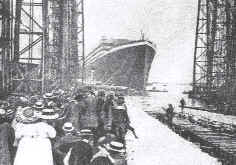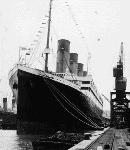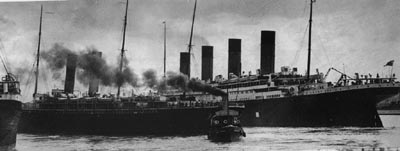 |
1861:
Harland
and Wolff Shipbuilding is founded in Belfast, Ireland.
 |
1867:
The unprofitable White Star Line is
purchased by Thomas Henry Ismay and Sir Edward Harland.
1891:
Thomas Ismay's eldest son, J. Bruce
Ismay is made a partner of the White Star line. One year later Thomas Ismay
retires.
1898:
The American author Morgan Robertson
(1861 - 1915) publishes the short fictional novel "Futility" in which
a British passenger liner called the 'Titan' hits an iceberg and sinks on her
maiden voyage without enough lifeboats in the month of April in the North
Atlantic.
 |
The fictional ship is eerily
similar to the yet-to-be conceived Titanic in size, speed, equipment,
numbers of passengers (both rich and poor), and those lost.
Both ships were British and sailed in April with a top speed of 24-25 knots.
They had the same passenger and crew capacity of 3,000 but sailed with a little
over 2,000. Also they were between 800 and 900 feet long and driven with triple
propellers. Each also sank 95 miles south of the banks of Greenland.
Here's the most astonishing fact: both ships sank after being pierced by an
iceberg on their starboard side.!.!.!
1902:
The White Star Line is taken over by
International Mercantile Marine Company founded by J. Pierpoint Morgan. The
purchase price is £10,000,000. J. Bruce Ismay stays on to eventually become the
managing director of the White Star Line.
 |
1907:
On a summer night in 1907, a dream to
build the most fantastic ships ever conceived was started in London by J. Bruce
Ismay, the Managing Director of the White Star Line, and Lord James Pirrie (a
partner in the firm of Harland
and Wolff Shipbuilding - the giant Belfast shipbuilder that built all the
White Star Line vessels) during a dinner party. They planned to build the luxury
ship Titanic and the Olympic. A third one, the 'Gigantic' (renamed
Britannic), to be built later. Cost of each ship £1,500,000.
  |
1909:
March 31st:
The construction of the Titanic
(keel number 401, official built number 131428) begins in Belfast, Ireland by
Harland and Wolff Shipbuilding. The Titanic's principal designer was
Alexander M. Carlisle. He retired in 1909 and was succeeded by Thomas Andrews.
 |
1910:
October 20th:
The Olympic, the first of three
enormous vessels in the "Olympic Class" and Titanic's sister
ship, was successfully launched. After final construction, she began her maiden
voyage in June, 1911. Before the completion of the Titanic, she was the
largest ship in the world and, later, regained that title until the construction
of the German ship Imperator.
1911:
May 31st:
The launch
of the Titanic.
12.05 p.m.: Two rockets were fired followed by a third rocket five
minutes later.
12.13 p.m.: The hull of a ship that was to become the most known ship in
the world gracefully started moving under her own weight down the slipway.
Twenty-two tons of tallow, soap, and train oil are used to grease the slipway
bed to coat and protect against the enormous three-tons-per-square-inch pressure
of the freshly painted hull. She travelled nearly twice her 900 foot length at
achieved twelve knots before being brought to a halt by six anchor chains and
two piles of cable drag chains, each chain weighing eighty pounds. The launch
lasted only sixty two seconds and was watched by over 100,000 spectators.
 |
Shipyard worker James Dobbins, age
43, had his legs pinned by a support he was cutting. His friends dragged him to
safety and he was taken to Belfast Royal Victoria Hospital where he died the
next day of contusions and shock.
The Titanic is being towed by tugs to the fitting-out basin. Ten months
of fitting out follow.
July:
First projected date agreed on by
White Star Line and Harland & Wolff for Titanic's maiden voyage -
March 20th, 1912.
September 20th:
The Olympic - Titanic's
sister ship, outbound from Southampton (with Captain Edward John Smith who would
later captain the Titanic), has a major collision with the HMHS HAWKE,
a British Royal Navy cruiser. Repairs made back at Harland and Wolff
Shipbuilding delay the fitting out of the Titanic one month due to
necessary diversion of workers and materials to repair the 'Olympic'.
 |
October 11th:
White Star Line officially announces
new date for Titanic's maiden voyage in the London Times - April 10th,
1912.
1912:
January:
Sixteen wooden lifeboats are installed
aboard the Titanic under "Welin quadrant" davits (designed to
handle two or three lifeboats).
Titanic's principal designer, Alexander M. Carlisle (who was no longer in
the employ of Harland & Wolff Shipbuilding) had suggested davits capable of
carrying more boats, but presented it as an economy measure, and not in the
interests of increased safety. Outdated British Board of Trade regulations mean
that Titanic's 20 lifeboats (including four "collapsible"
canvas-sided lifeboats) actually exceed requirements by ten percent capacity.
 |
March 31st:
The outfitting of the Titanic
is completed. She emerged from the fitting out basin with the most luxurious
fittings of any ship ever built.
 |
April 1st:
Titanic's sea trials are
delayed due to high winds.
April 2nd:
6.00 a.m.: Sea trials begin.
The Titanic assisted by two tugs sails through Victoria Channel to
Belfast Lough. All equipment tested, including wireless. Speed and handling
trials undertaken, including various turning and stop-start maneuvers. Major
stopping test conducted: runs full ahead at 20 knots and then stops full astern.
2.00 p.m.: Running test conducted. She travels for about two hours (about
40 miles) out into the open Irish Sea at an average speed of 18 knots, and then
returns in two hours to Belfast. All tests meet Board of Trade standards. Trials
have lasted less than a day.
8.00 p.m.: The Titanic leaves Belfast (under Captain Bartlett) for
overnight trip to Southampton, her port of embarkation (about 570 miles).
 |
April 3rd:
The Titanic arrives in the port
of Southampton just after midnight to begin provisioning and staffing for maiden
voyage.
April 5th:
The Titanic is
"dressed" in panoply of flags and pennants for a salute to the people
of Southampton. This is the only occasion she is ever "dressed".
 |
April 6th:
Recruitment day for remainder, and
majority, of crew. General cargo begins to arrive. The final total cargo
includes 559 tons and 11,524 separate pieces. As well an additional 5,892 tons
of coal are loaded on board.
April 8th:
Fresh food supplies taken on board. All final preparations overseen by
the ship's designer Thomas Andrews down to the tiniest detail.
April 10th:
Sailing Day.
7.30 a.m.: Captain Edward John Smith
boards the Titanic with full crew. The officers have spent the night on
board. Captain Smith receives sailing report from Chief Officer Wilde.
 |
Back row,
Left to Right:
Chief Purser Herbert McElroy, Fourth Officer Joseph Grove Boxhall, Sixth Officer
James Pell Moody, Fifth Officer Harold Godfrey Lowe, Third Officer Herbert John
Pitman.
Front row, Left to Right: Second Officer Charles Herbert Lightoller,
Chief Officer Henry Tingle Wilde, Captain Edward John Smith, First Officer
William McMaster Murdoch.
8.00 a.m.: Entire crew mustered, followed by brief lifeboat
drill using only two starboard boats, No's 11 and 15. Mail is taken aboard the Titanic.
9.30 a.m. - 11.00 a.m.: The Second and Third-Class boat trains arrive at
the dockside.
The Second-Class passengers and Third-Class Passengers or "Steerage"
board ship.
11.00 a.m. - 11.30 a.m.: Arrival of the First-Class boat-train from
London at the dockside.
The First-Class passengers board ship and are escorted to their cabins.
 |
Noon: The Titanic casts off and begins her maiden voyage.
She has a near miss with the steamer 'New York' caused by the suction of Titanic's
enormous displacement.
 |
1.00 p.m.: The Titanic sails down the English Channel
for Cherbourg, France.
4.00 p.m.: Late arrival announced in Cherbourg.
5.30 p.m.: Passengers board tenders and wait for the Titanic to
arrive.
6.30 p.m.: The Titanic rides at anchor in Cherbourg, France.
8.10 p.m.: The Titanic leaves for Queenstown, Ireland
April 11th:
Various practice turns are being tested during the morning.
11.30 a.m.: The Titanic arrives at Queenstown.
1.30 p.m.: Anchored off of Roche's Point, Queenstown, Ireland, Francis
Browne, a Jesuit seminarian, disembarks and takes the last known photograph of
the Titanic for the next 73 years. The Titanic would sail into
history, leaving in her wake a trail of tragedy, mystery, intrigue and
fascination by millions. The Titanic leaves Queenstown for New York.
 |
April 11th - 12th:
The Titanic sails through calm waters and covers 386 miles.
April 12th - 13th:
The Titanic sails through calm waters and covers 519 miles.
Ice warning is received from the steamer 'Rappahannock'.
April 13th:
1.00 p.m.: The Chief Engineer Joseph Bell reports the coal
fire in boiler room #6, coal bunker #10 (which already had started in
Southampton).
3.00 p.m.: Captain Smith and Bruce Ismay discuss the voyage.
April 14th:
Sunday.
Several ice warnings are received during the day. Reports come in from
the 'Noordamm', 'Caronia', 'Baltic', 'Amerika', 'Californian' and 'Mesaba'.
10.30 a.m.: Church Service is being held in the
First-Class dining saloon.
10.00 p.m.: Second officer Lightoller relieved on bridge by First
officer Murdoch. Lookouts in crow's nest relieved. Warning to watch for icebergs
passed between the watches. Temperature is 32º F, sky cloudless, air clear.
11.39 p.m.: The Titanic is steaming at 20.5 knots.
Suddenly, the lookouts, Fredrick Fleet and Reginald Robinson Lee,
see an iceberg dead ahead about 500 yards away towering some 55-60 feet above
the water. They immediately sound the warning bell with three sharp rings and
telephone the bridge: "Iceberg right ahead." Sixth officer Moody on
the bridge acknowledges warning, relays message to First officer Murdoch who
instinctively calls "hard-a-starboard" to the helmsman William
Hitchens and orders the
engine room to stop engines and then orders full astern. Murdoch then activates
the lever to close all watertight doors below the waterline. Hitchens spins
the wheel as far as it will go. After several seconds, the Titanic begins
to veer to port, but the iceberg strikes starboard bow side and brushes along
the side of the ship and passes by into the night. The impact, although jarring
to the crew down in the forward area, is not noticed by many of the passengers.
Thirty-seven seconds have passed from sighting to collision.
  |
11.50 p.m.: Captain Smith asks designer Thomas Andrews and the
ship's carpenter John Hall Hutchinson to conduct a visual inspection of the
damage. They tell Captain Smith that water had poured in and risen 14 feet in
the front part of the ship.
 |
April 15th:
Monday.
12:00 a.m.: The captain is told the ship can only stay afloat for
a couple of hours.
He gives order to the wireless operators to call for help over the radio.
The boilers are shut down and relief pipes against the funnels blow off huge
noisy clouds of steam.
The Titanic's estimated position: 41º 44' N, 50º 24' W.
 |
 |
|
12.05 a.m.: Orders
are given to uncover the lifeboats and to get passengers and crew ready
on deck. There is only room for half of the estimated 2,227 aboard in
the lifeboats.
Passengers in lifeboat 12.15 a.m. - 2.17 a.m.:
Numerous ships receive the Titanic's distress signal, including
her sister ship the Olympic,
some 500 miles away. Several ships, including 'Mount Temple' (49 miles
away), 'Frankfort' (153 miles away), 'Birma' (70 miles), 'Baltic' (243
miles), 'Virginian' (170), and 'Carpathia' (58 miles) prepare at various
times to come to assist.
Both Marconi Operators John George Phillips and Harold Bride 12.35 a.m.: Fourth
Officer Boxhall notices a light in the distance and assume it is a ship
which may rescue them. He asks Captain Smith about lighting the rockets
and Captain Smith agrees.
The Titanic firing distress rockets 1.15 a.m.: The tilt
of the deck grows steeper. Lifeboats now begin to leave fully loaded.
Father Thomas Roussel Davids Byles 2.18 a.m.: The
ship's lights blink once then go out. Several survivors see the ship
break in two. The bow section sinks.
The Titanic sinking 3.20 a.m.: The final
cries of the drowning people in the water fade away.
The White Star Office in New York after the sinking
The 'Carpathia' April 18th:
Titanic's
lifeboats in the White Star pier, New York.
'Carpathia's' captain Arthur Henry Rostron April 17th - May
25th:
The 'Mackay-Bennett' leaving Halifax Harbour April 17th, 1912 April 19th - May
25th: April 24th: April 30th: May 2nd - July 3rd: May 14th: 1913: June: 1914: 1916: 1932:
Mrs. Margaret Tobin Brown ("The Unsinkable Molly Brown") 1935: 1937: 1955: 1964: 1980: 1980: 1981: 1983: 1985:
Dr. Robert D. Ballard Final resting place of the Titanic:
41°44' North; 49°57' West 1986:
The Titanic's final resting place 1987: 1987: October: 1988: 1989: 1991: 1991: 1993: 1994: 1994: 1995: April 15th: 1996: 1997: 1998: April 6th: August 10th:
A
piece of Titanic's hull (the "Big Piece") August 15th: 2000: |